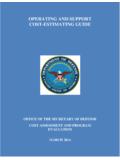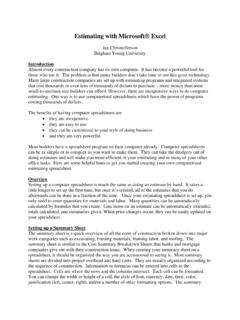Transcription of Process Equipment Cost Estimating by Ratio and Proportion
1 PDH Course G127 Process Equipment cost Estimating by Ratio and Proportion 2012 Randall W. Whitesides, CPE, PE 1 Process Equipment cost Estimating by Ratio and Proportion Copyright 2012 Randall W. Whitesides, Course Overview Students of this one-hour course will be provided with two simple methods to arrive at approximate Equipment costs during preliminary estimate preparation. Learning Objective At the conclusion of this course the student will: Understand the applicability of Ratio and Proportion Estimating methods; Learn the technique to factor costs to correspond to varying Equipment sizes and capacities; Learn the technique to escalate or otherwise adjust historical costs.
2 Intended Audience This course is intended for anyone involved with cost estimate generation. Benefits for Attendees This course will provide new methods of Estimating for some and refresher information for others. The course material can be used as a reference source for actual future situations. The course includes a true-false test at the end. Introduction This course provides the student with an understanding of the Estimating technique known as The Rule of Six-tenths and when appropriate, use of this rule in combination with cost indices. The various types of estimates are discussed as prerequisite background.
3 Equations are provided to enable the student to escalate or otherwise adjust historical Equipment cost data. Content cost Estimate Types and Accuracy Regardless of accuracy, capital cost estimates are typically made-up of direct and indirect costs. Indirect costs consist of project services, such as overhead and profit, and engineering and administrative fees. Direct costs are construction items for the project and include property, Equipment , and materials. This course deals with the Equipment component of direct cost . PDH Course G127 Process Equipment cost Estimating by Ratio and Proportion 2012 Randall W.
4 Whitesides, CPE, PE 2 In order for the student to fully understand the applicability of Ratio and Proportion Estimating , it will be helpful to list the types of estimates that exist. cost estimates fall into the following categories and generally accepted accuracy: As the names imply, the main difference between these types of estimates is their accuracy. The first three types serve as a cost indicator at a very early stage of the project design stage. They are developed with a minimum amount of detailed engineering and advise a client or a management group of that first look at project cost .
5 The preparation of a preliminary estimate is done by an estimator based on his assessment of the design, past cost estimates, in-house Estimating information, and previous contracts and purchase orders. It is not normal to obtain formal quotations from Equipment manufactures in support of a preliminary estimate. Informal telephone budget quotations on identified major Equipment such as vessels, filters, etc. are acceptable. However, even these types of expedient quotations can prove to be time restrictive to obtain sometimes. Even with the advent of sophisticated Estimating software it is sometimes simply easier to manually approximate an Equipment cost .
6 That is the subject of this course. Definitive and detailed cost estimates are full-blown exercises that are undertaken to produce a competitive bid submission or otherwise produce an accurate (plus or minus 10% or better) cost estimate, for say, a corporation s management approval for appropriation of funds. The Ratio and Proportion methods presented in this course would not be normally suitable for inclusion in a definitive estimate. The Equipment cost Estimating methods that will be outlined in this course are suitable for use with the first three types of estimates; definitive and detail estimates require formal, firm Equipment cost quotations from Equipment manufacturers and suppliers.
7 PDH Course G127 Process Equipment cost Estimating by Ratio and Proportion 2012 Randall W. Whitesides, CPE, PE 3 Ratio and Proportion Estimating A Ratio indicates the relationship between two (or more) things in quantity, amount, or size. Proportion implies that two (or more) items are similar, differing only in magnitude. Using these well-known mathematical tools is a simple Process . When preparing preliminary estimates, two methods for Estimating the cost of Equipment are the Rule of Six-tenths and the use of cost indices to adjust historic costs to current prices.
8 Each will be discussed and a single example will be offered to demonstrate the use of both. The Rule of Six-tenths Approximate costs can be obtained if the cost of a similar item of different size or capacity is known. A rule of thumb developed over the years known as the rule of six-tenths gives very satisfactory results when only an approximate cost within plus or minus 20% is required. An exhaustive search in conjunction with the development of this course left this author with no indication of any single individual who developed this concept. One is forced to assume that the relationship naturally evolved in the public domain after large quantities of actual cost data were analyzed retrospectively.
9 The earliest mention of this concept was found in a reference accredited to a December 1947 Chemical Engineering magazine article by Roger Williams, Jr. entitled Six-tenths Factor Aids in Approximating Costs . At any rate, the following equation expresses the rule of six-tenths: CCSSBABA 06. Where CB = the approximate cost ($) of Equipment having size SB (cfm, Hp, ft2, or whatever) CA = is the known cost ($) of Equipment having corresponding size SA (same units as SB), and SB/SA is the Ratio known as the size factor, dimensionless. ( Ratio ) PDH Course G127 Process Equipment cost Estimating by Ratio and Proportion 2012 Randall W.
10 Whitesides, CPE, PE 4 The N exponent An analysis of the cost of individual pieces of Equipment shows that the size factor s exponent will vary from to unity, but the average is very near to , thus the name for the rule of thumb. If a higher degree of sophistication is sought, Table 1 below can be used. It lists the value of a size exponent for various types of Process Equipment . The Table 1 values have been condensed from a vast, comprehensive tabulation of Estimating cost data presented in the March 24, 1969 issue of Chemical Engineering magazine. This article by Guthrie is entitled Data and Techniques for Preliminary Capital cost Estimating .














